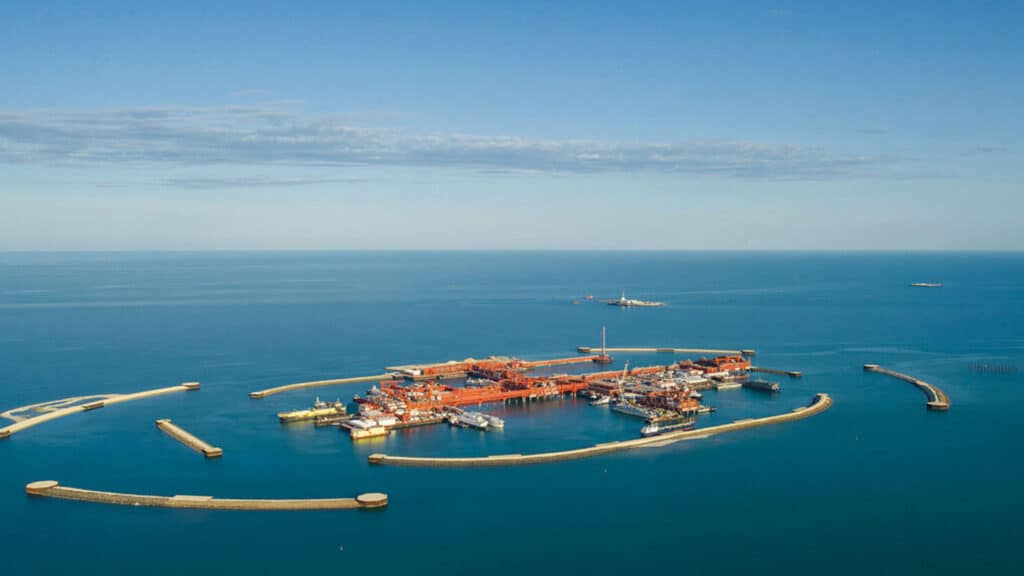
Kashagan, Kazakhstan’s largest oil and gas field on the Caspian shelf, is scheduled for an equipment upgrade in 2026, according to the North Caspian Operating Company N.V. (NCOC), the field’s operator.
Holding production steady
The planned upgrade will enable additional lines to be connected to the existing process pipeline system at the Integrated Oil and Gas Treatment Plant (IOGTP), also known as the Bolashak onshore processing facility, without interrupting production.
A memo from NCOC, reviewed by Kursiv.media, states that the primary goal of the project is to eliminate bottlenecks at the IOGTP. The upgrade will include minor modernization of the facility’s process lines, such as replacing thermowells and upgrading naphtha stripping columns. As part of the plan, tie-in points will be installed in the existing pipeline system at the Bolashak facility, enabling future connections of additional lines while maintaining continuous operations.
Construction and installation work is scheduled for the second and third quarters of 2026, with commissioning expected in the third quarter.
NCOC reported that the work will not impact oil production and preparation at the IOGTP, nor will it affect overall output. KazMunayGas (KMG), Kazakhstan’s national oil and gas company, reported that oil production at Kashagan is expected to reach 17.8 million tons in 2025, up from 17.4 million tons in 2024. Cumulative production at the field is projected to hit 1 billion barrels by the end of 2025.
The Bolashak facility, which processes output from the Kashagan field, is located approximately 40 kilometers northeast of Atyrau and about 8 kilometers east of the main highway and the Zapadny Eskene railway junction.
Kashagan’s troubled development
Considered one of the world’s most expensive oil projects, Kashagan has faced numerous challenges over the years and has been entangled in corruption scandals.
In March 2025, PSA, a state-owned entity established by the Kazakh government, filed a civil lawsuit in Switzerland alleging that embezzlement schemes tied to the Kashagan and Karachaganak oil fields were used to bribe Kazakh officials and funnel payments to certain executives and intermediaries at Eni, one of NCOC’s stakeholders, between 2006 and 2011.
Arbitration proceedings over Kashagan could drag on until 2028, according to a new investigation by the International Consortium of Investigative Journalists (ICIJ).
Kazakhstan’s government argues that the unequal revenue distribution stems from a production sharing agreement (PSA) signed in 1997. That agreement was amended in 2008 to address Kazakhstan’s concerns. Still, changes — specifically the addition of priority payments (royalties) — boosted the country’s revenue share by only about one percentage point, an expert analysis said.
In January 2025, Kazakhstan’s President Kassym-Jomart Tokayev instructed the cabinet to renegotiate existing PSAs with international companies on more favorable terms.
Under the current contracts, international energy firms provide the financing, expertise and technology to develop challenging oil fields. They recover costs during the early production phase and only afterward share profits with the host government.
According to oil and gas expert Nurlan Zhumagulov, one of the key conditions for increasing Kazakhstan’s share of profitable oil, which currently accounts for just 10% of profits and 2% of total production, is reaching a cumulative output of 3 billion barrels. At the current pace, this could take at least another decade. Meanwhile, investors are reportedly hesitant to proceed with stages 2B and 2C of the Kashagan’s development. These phases include boosting production by 200,000 barrels per day and constructing a new onshore oil and gas processing facility, respectively.
Additionally, Kazakhstan has emphasized the need to increase local content in the procurement of goods, services and labor for major oil projects, citing persistently low levels of localization.
According to Zhumagulov, the lack of significant progress in developing the Tengiz and Kashagan fields over the past 30 years is primarily due to economic factors. He argues it remains more profitable for importers to deliver goods directly, avoiding import duties and value-added tax (VAT). The expert noted that while local manufacturers still pay VAT on imported raw materials, the government does not reimburse this tax. As a result, domestic factories incur additional costs, while operators such as Tengizchevroil and NCOC purchase imported products VAT-free, undercutting local producers and making their operations financially unsustainable.
Kashagan is the first offshore oil and gas field developed in Kazakhstan’s sector of the Caspian Sea. Recoverable reserves are estimated at 9 billion to 13 billion barrels of oil. Commercial production began on Nov. 1, 2016.
The NCOC consortium includes several key stakeholders: KMG Kashagan B.V. (16.877%), Shell Kazakhstan Development B.V. (16.807%), Total EP Kazakhstan (16.807%), Agip Caspian Sea B.V. (16.807%), ExxonMobil Kazakhstan Inc. (16.807%), CNPC Kazakhstan B.V. (8.333%) and Inpex North Caspian Sea Ltd. (7.563%). NCOC has invested approximately $60 billion in the project.














